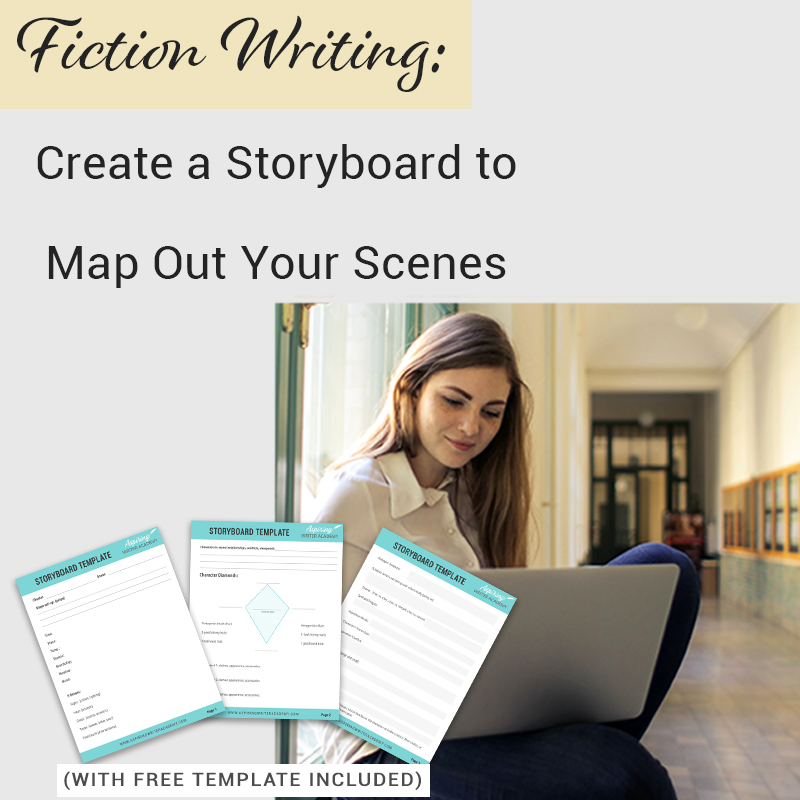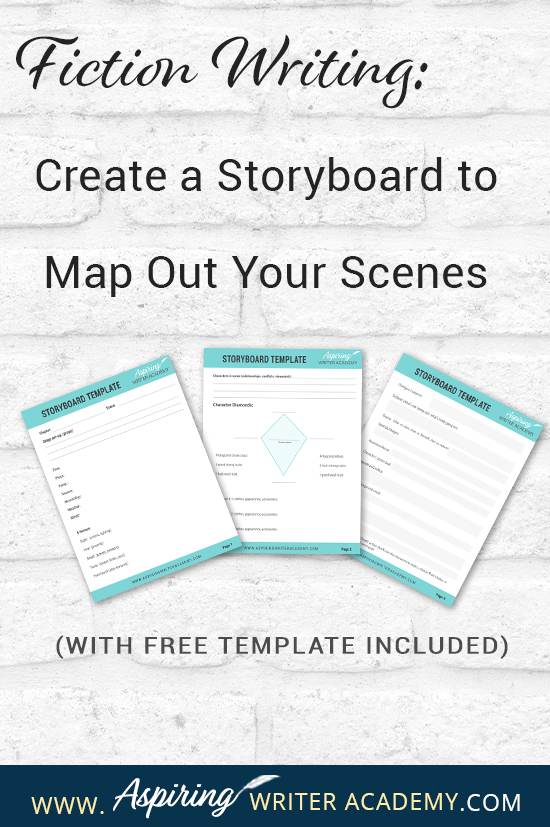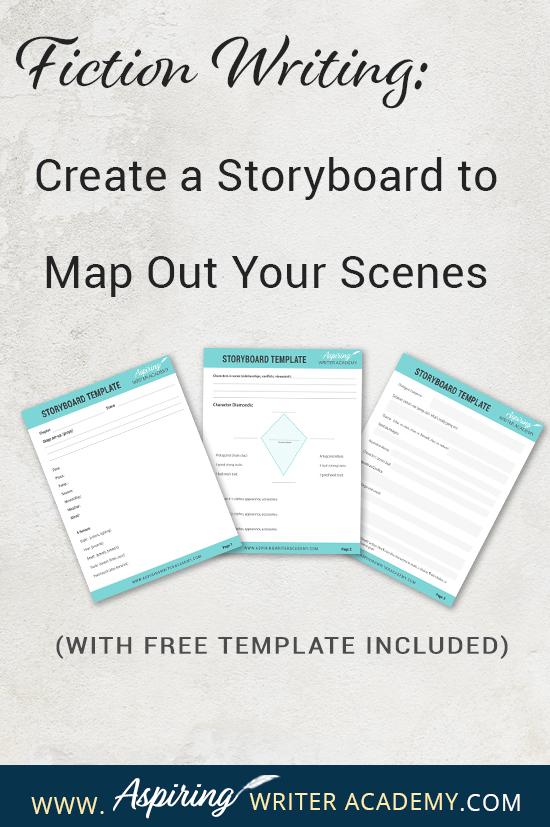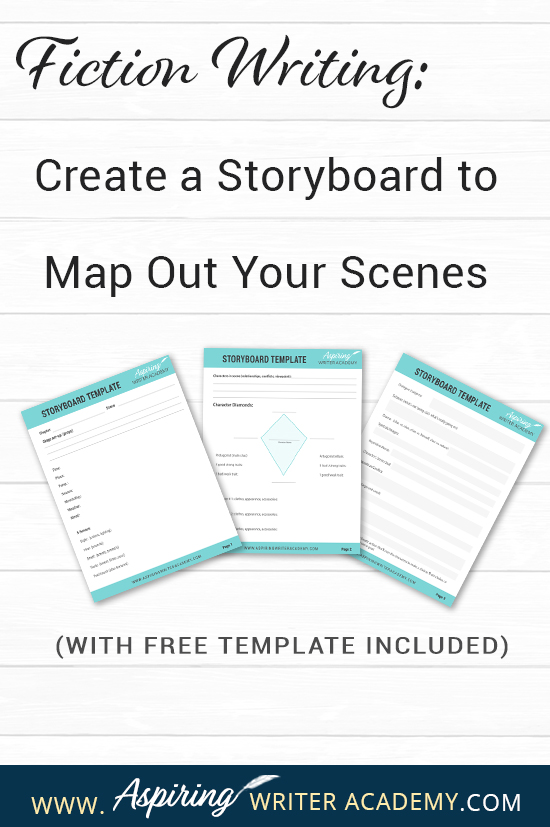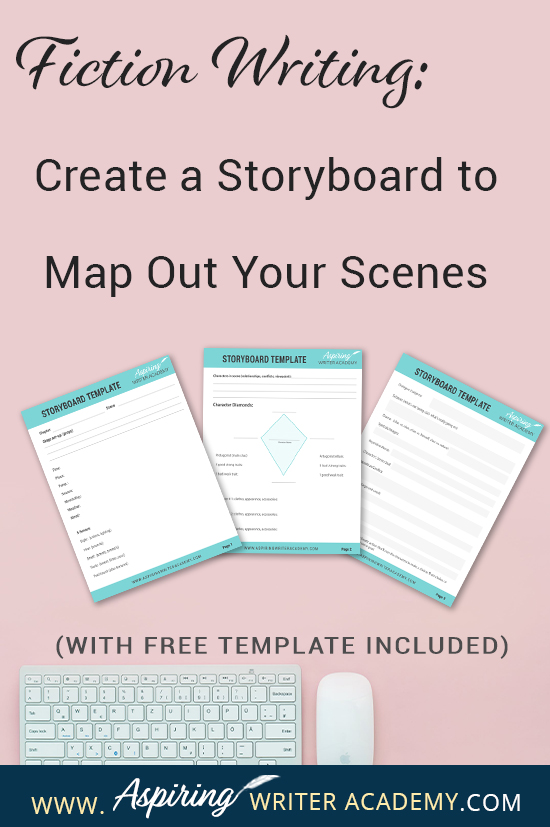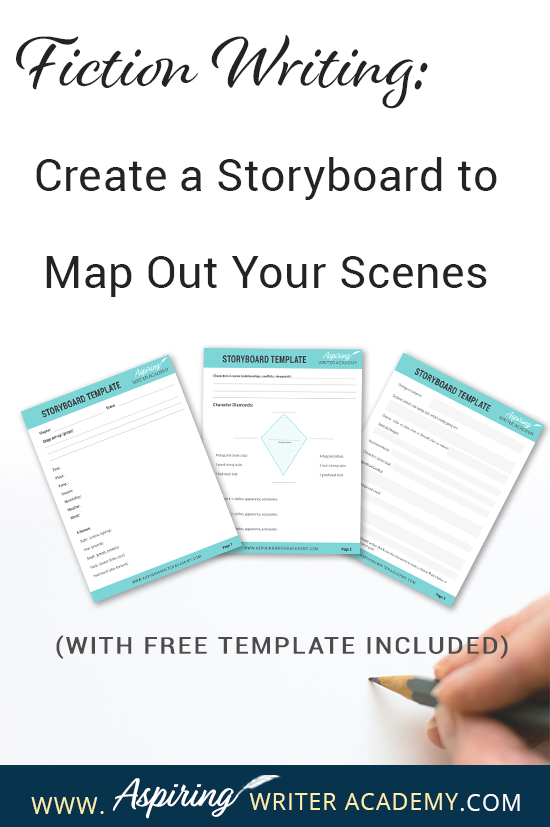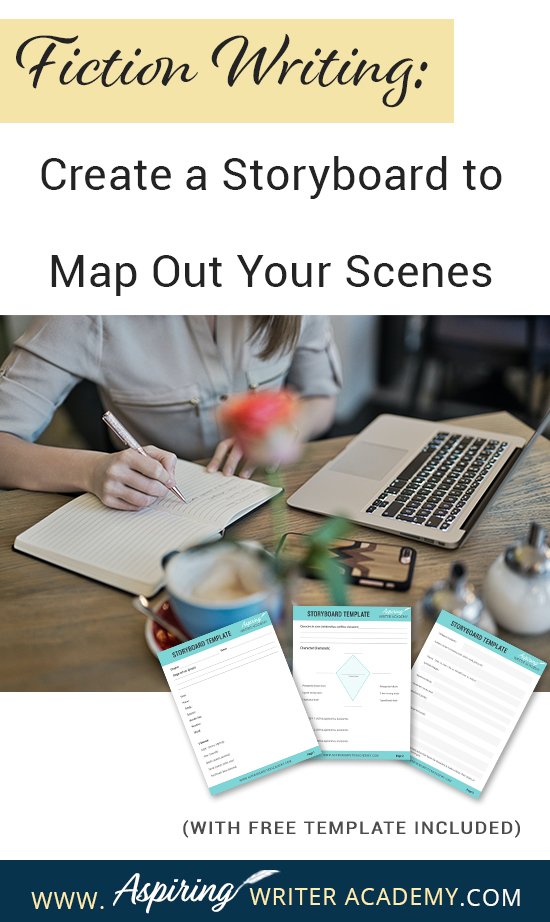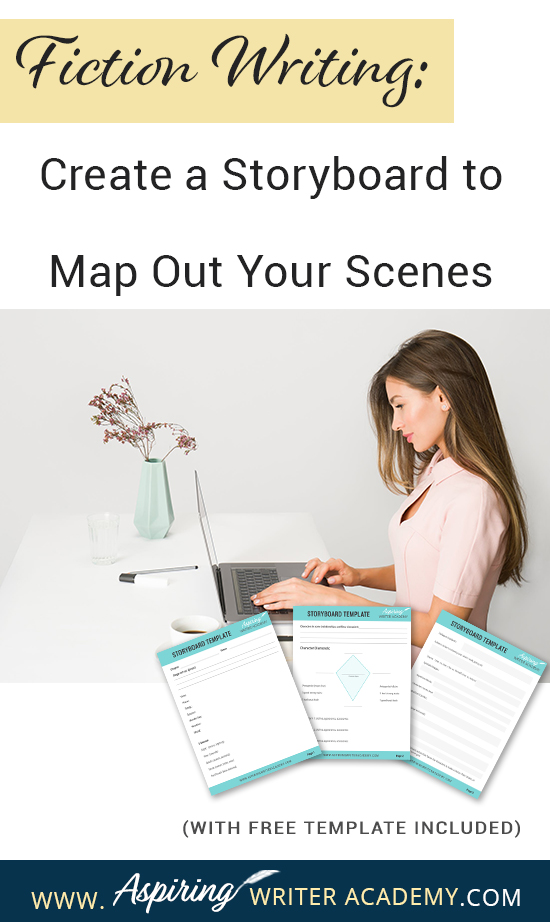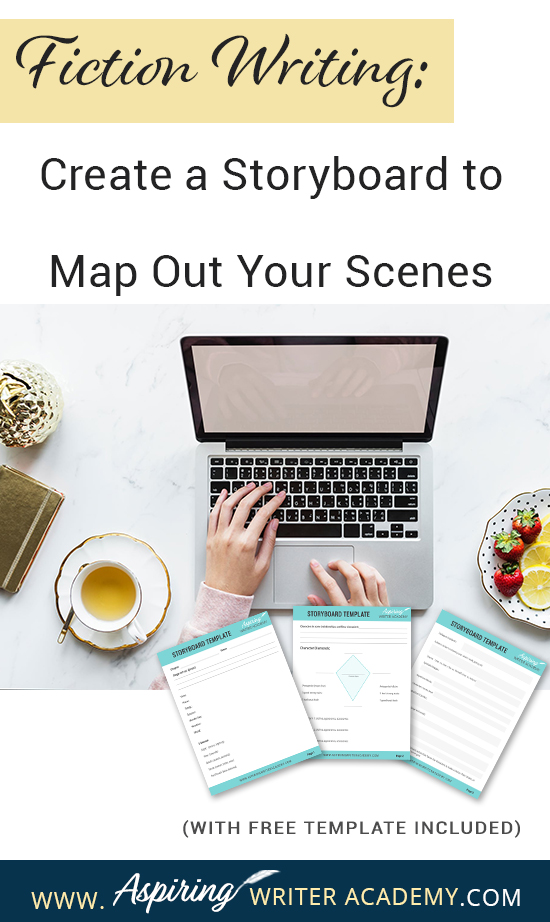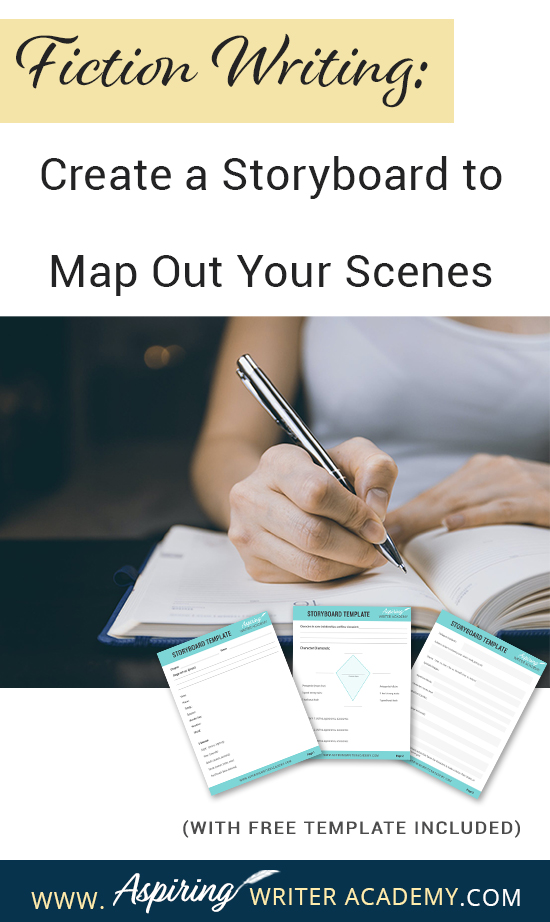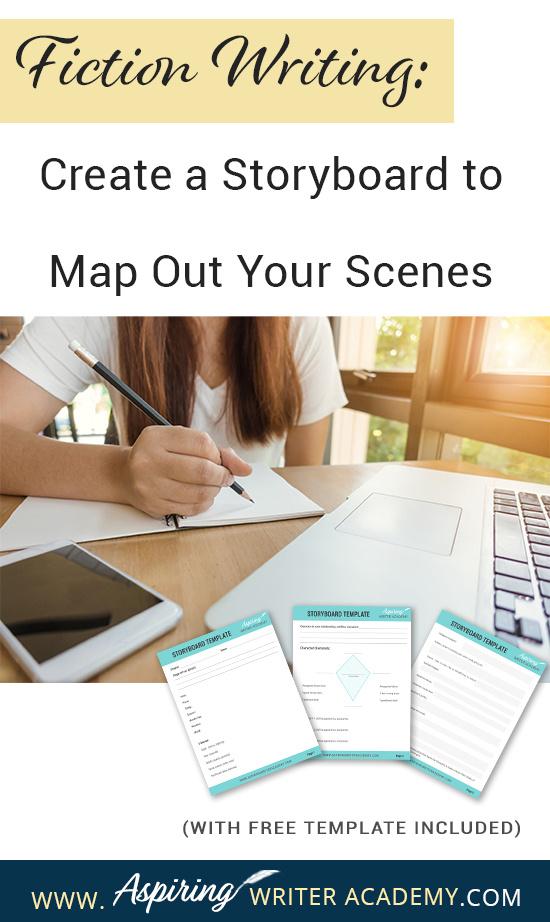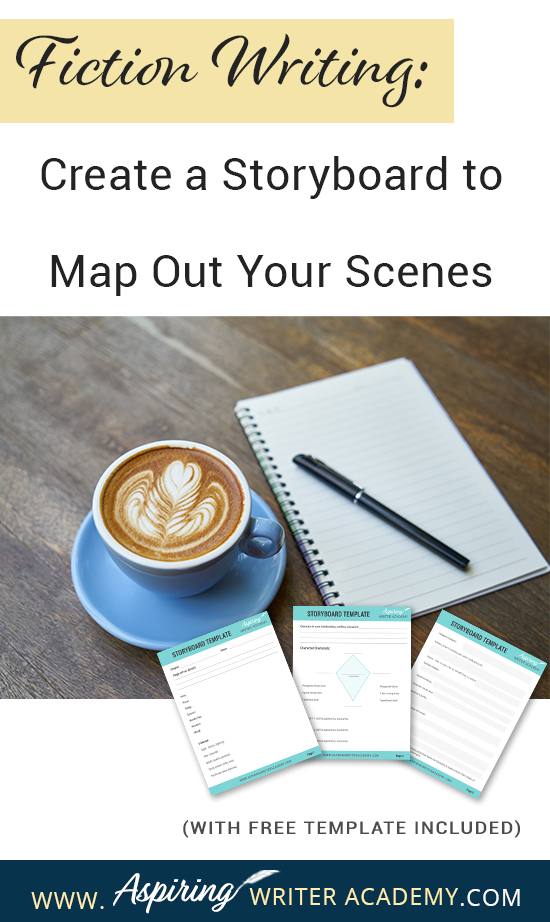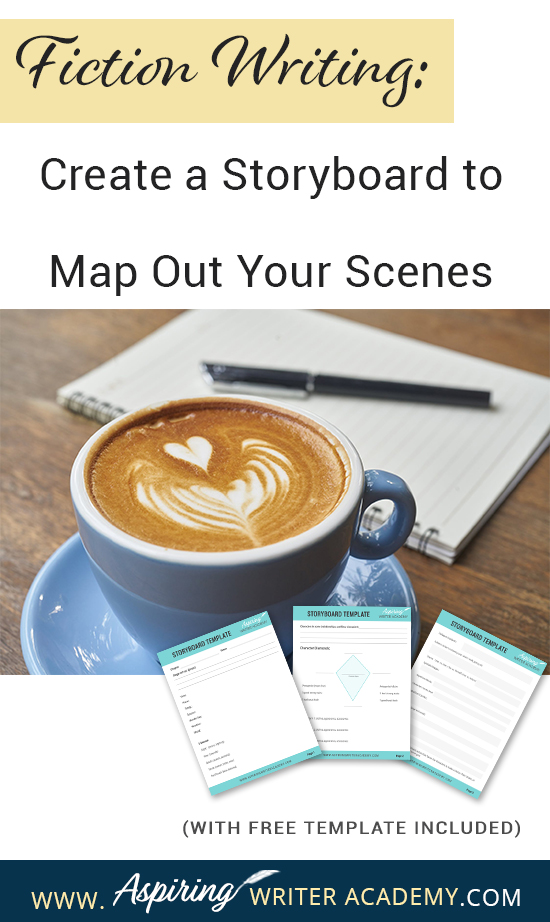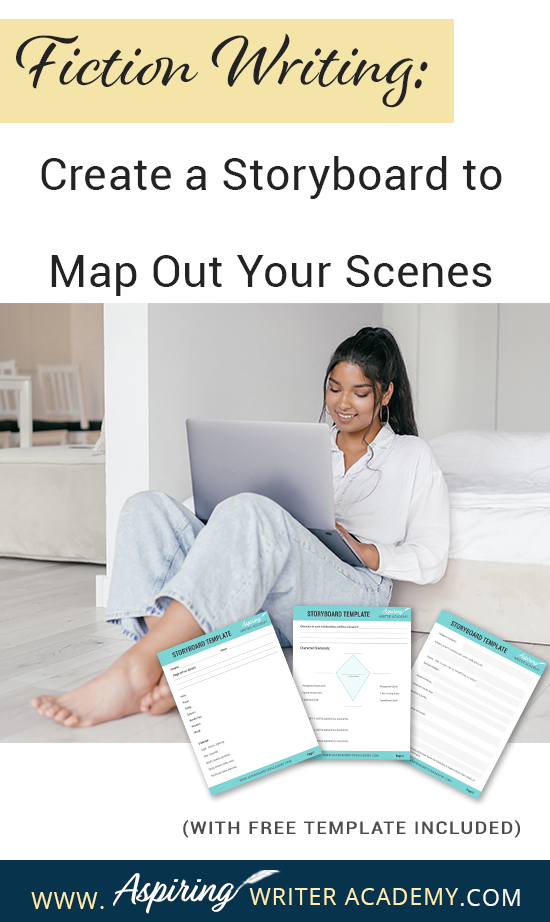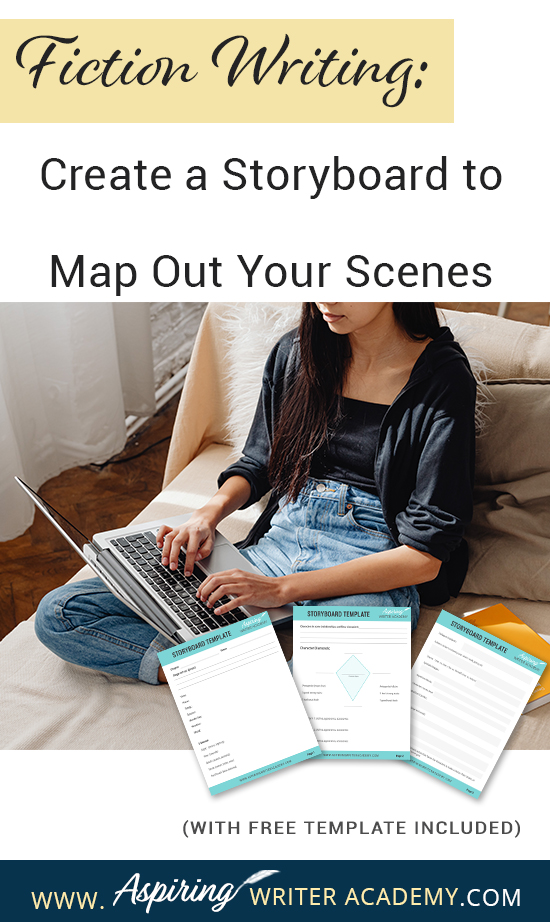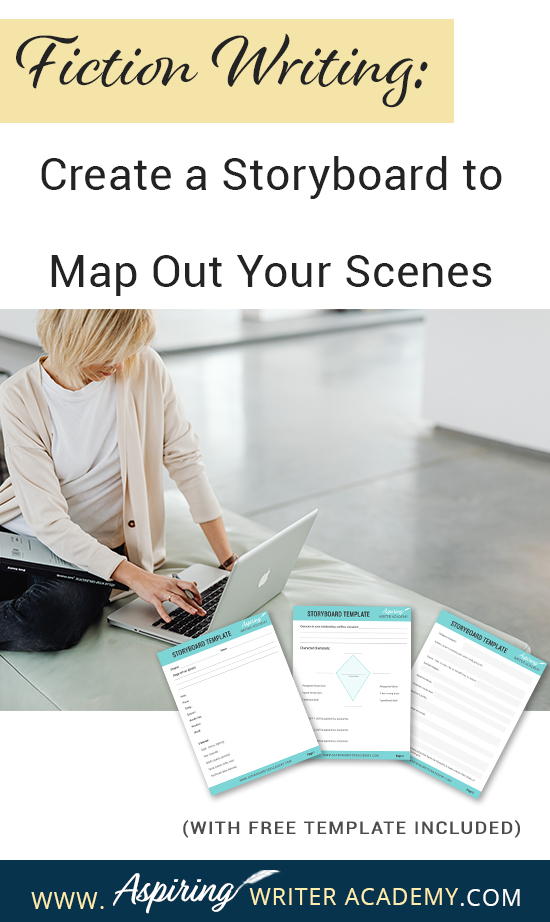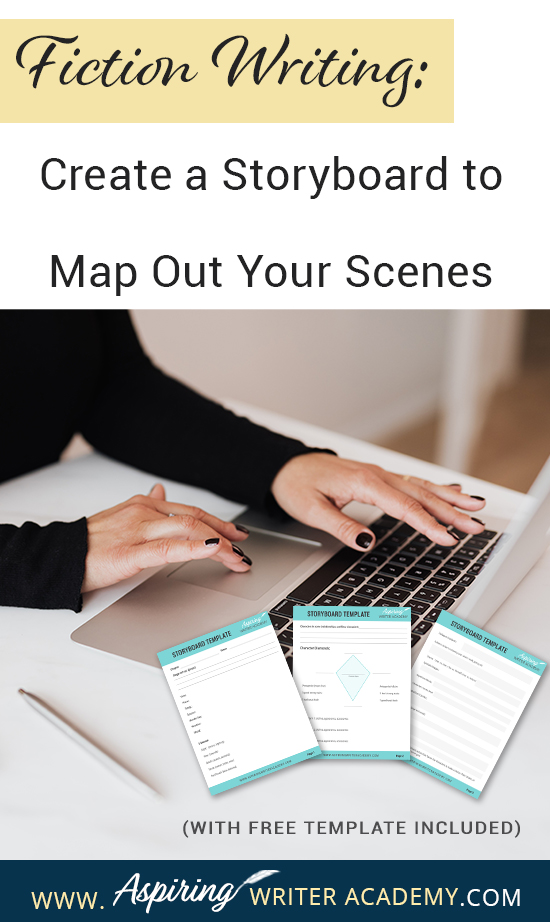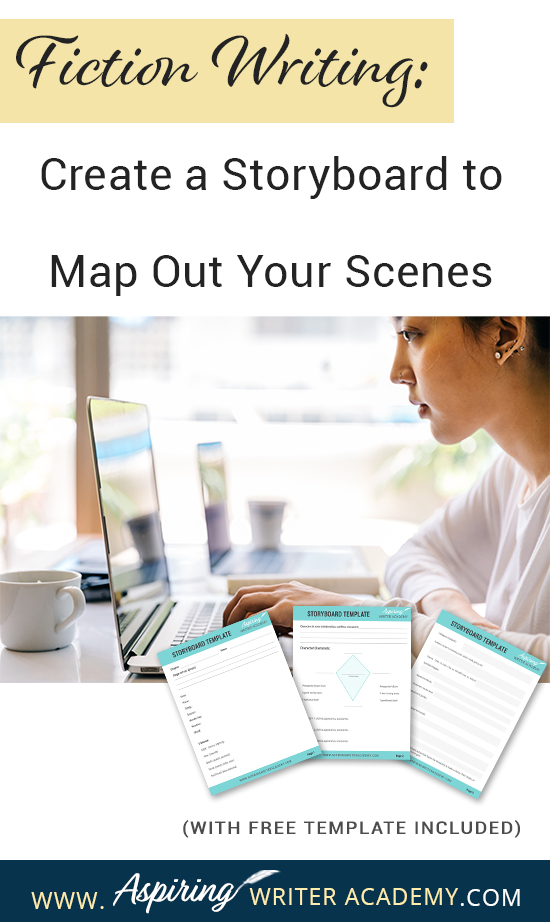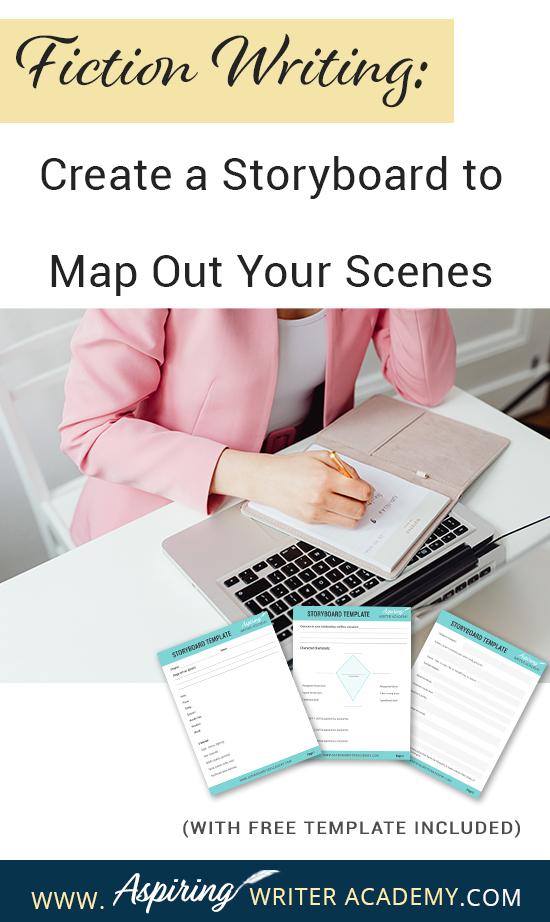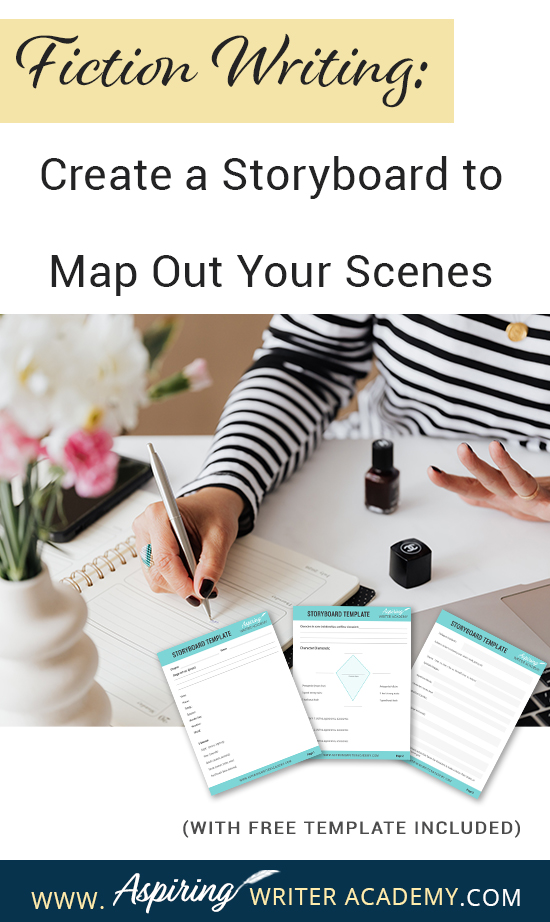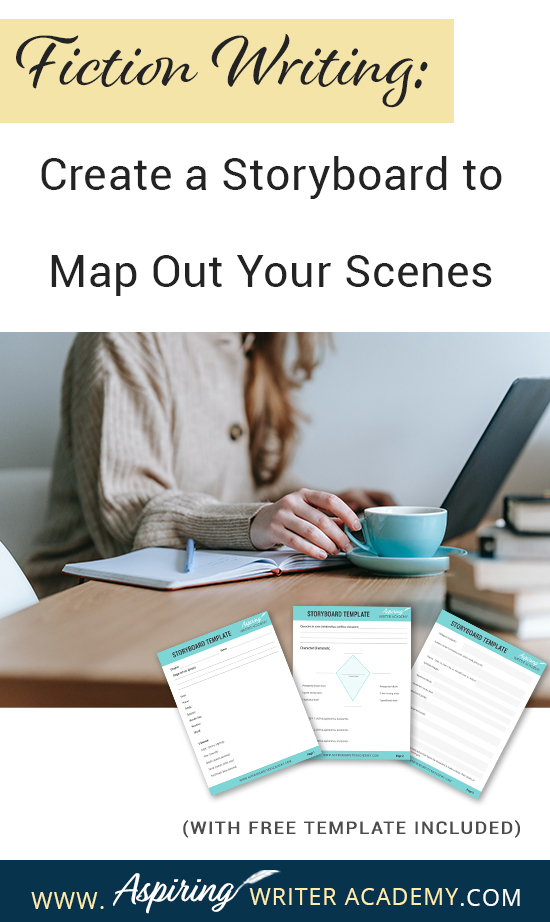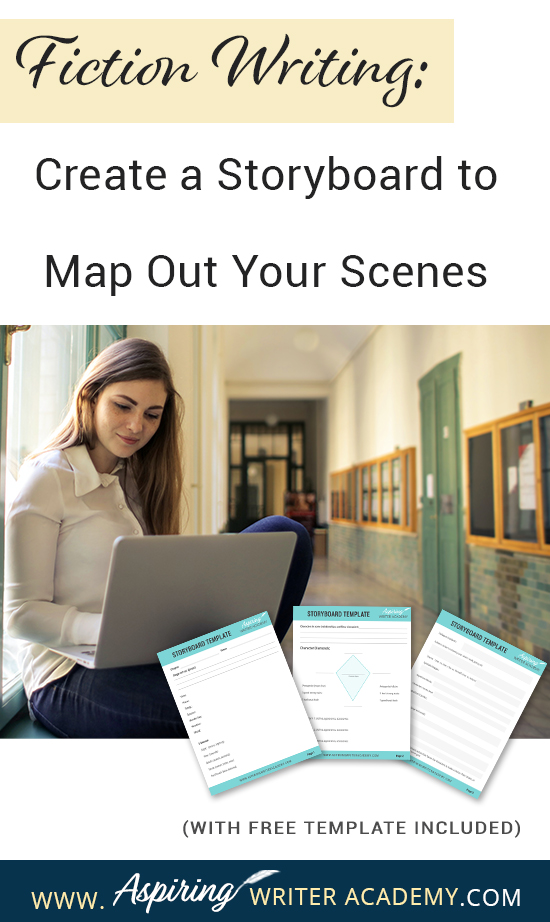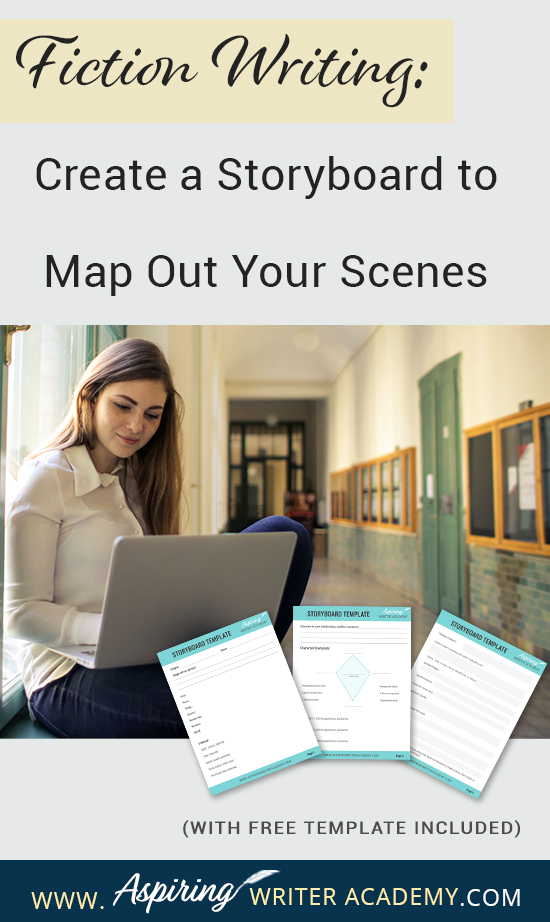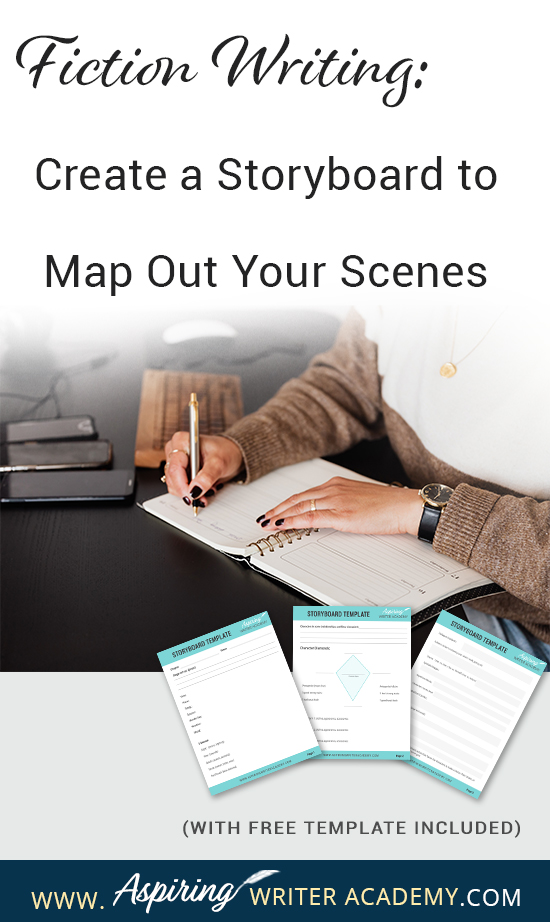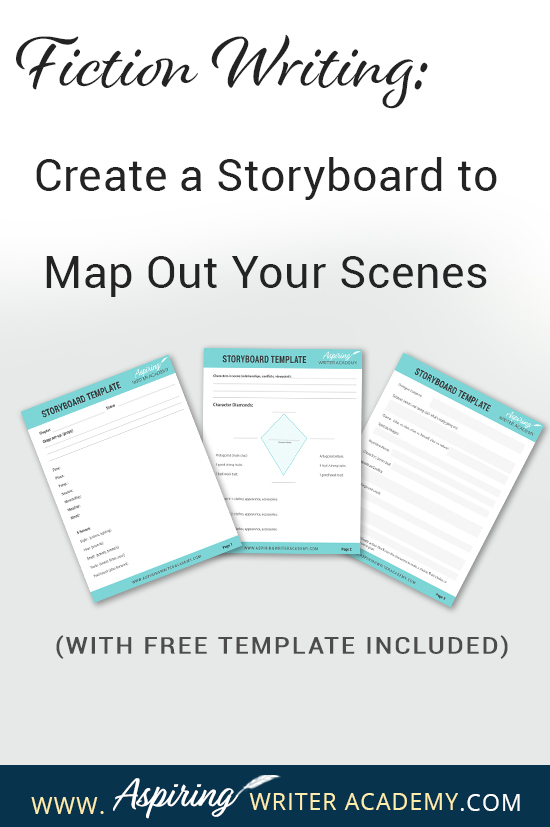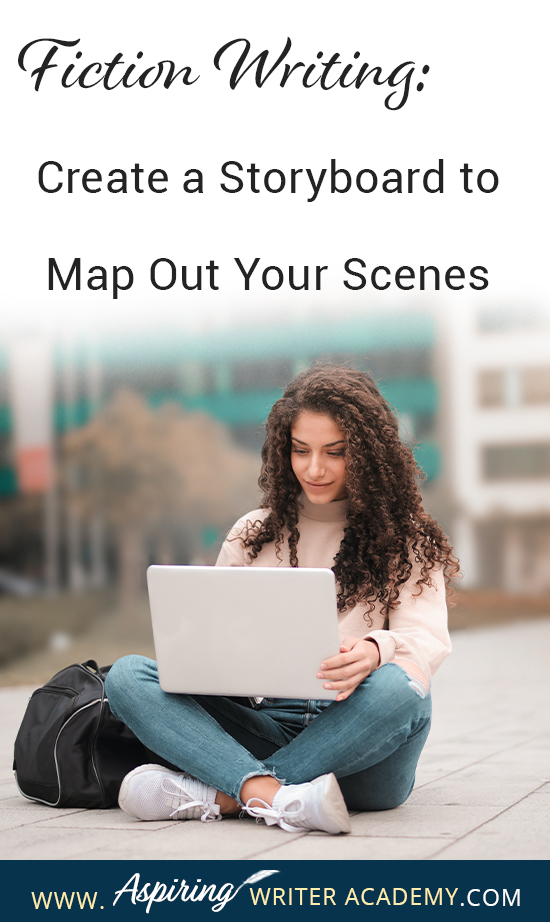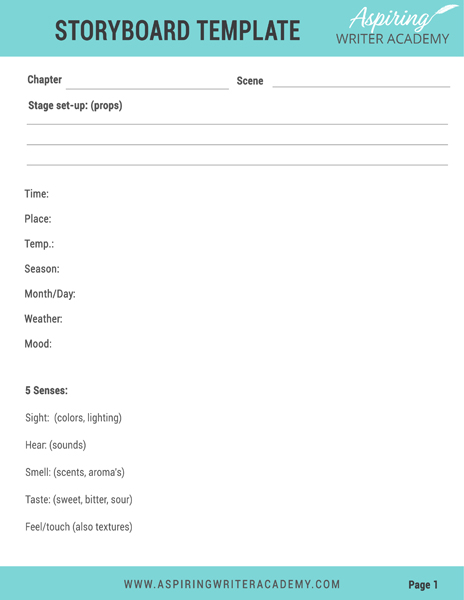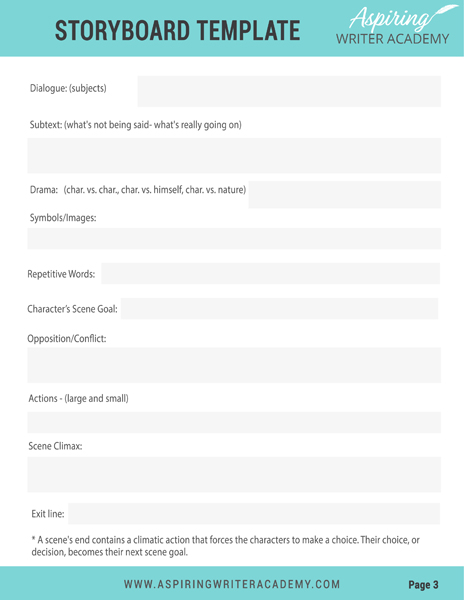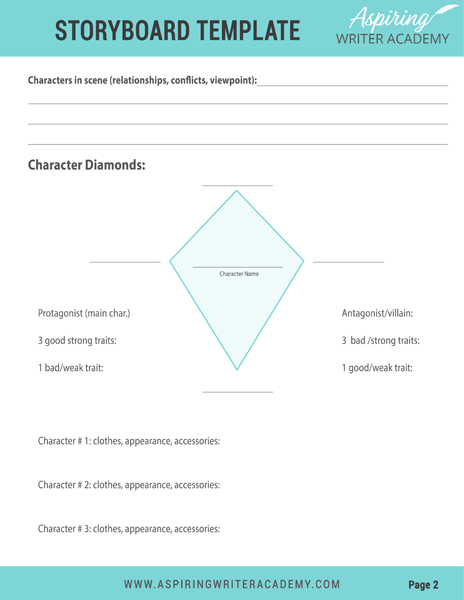Fiction Writing: Create a Storyboard to Map Out Your Scenes
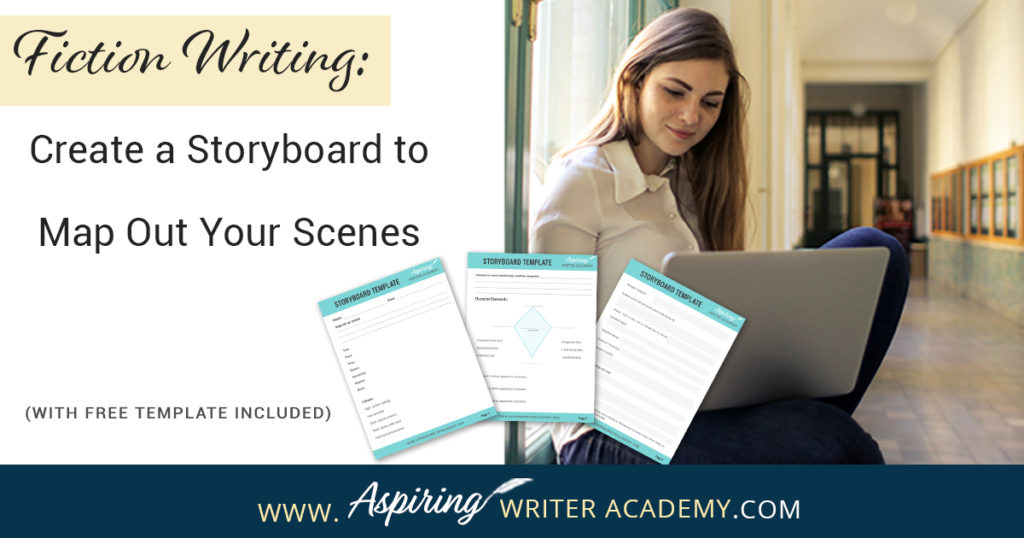
What is the first step to writing a scene?
While some writers just wait to see what comes to mind, it is helpful for most writers to have a plan. A plan saves you time by helping you to avoid the frustration of intense rewriting later.
Figuring out the scene details and objectives on a “Storyboard” beforehand allows you to write your scenes with ease. Our template acts as a guide, yet still lets you maintain the creative freedom and joy found in the actual writing of the scene.
If you are unsure how to craft a vibrant, compelling, purpose-filled scene, follow along as we help you with the framework in our post, Fiction Writing: Create a Storyboard to Map Out Your Scenes, with our Free Template.
In the post below we will discuss:
- Setting and Stage Set up
- The 5 Senses
- Character Diamonds
- Dialogue and Subtext
- Escalating Conflict
- The Exit Line
What exactly is a Storyboard?
Often used by screenwriters for the pre-visualizing of a motion picture or by animation studios, a “Storyboard” gives you a visual representation of the project you are undertaking to help you make many of the critical decisions before the actual creation process.
For our own purposes, a Storyboard helps you visualize and outline the scene before you write it.
How to Use the Storyboard Template:
At the top, you will see the headings:
Chapter:__________________
Scene:___________________
Simply fill in the blank to indicate which Chapter (Chapter 1?) you are drafting and which scene (Scene 2?) you are working on within that chapter, so that if you draft several Storyboards for different scenes, you can keep them in order.
Is it necessary to create a Storyboard for every scene in your novel?
No. After you draft a few Storyboards and are familiar with the set up, you will find it is not necessary to create a Storyboard for every single scene.
However, you may keep a blank Storyboard template beside your computer as you write to use as a guide. Many authors fill out Storyboards for only the largest, most powerful scenes. Many of these larger scenes are the pivotal, emotional, detailed turning points in the story.
Other writers may write the scene like a ‘Pantser,’ letting the words spill out from their head onto the page with no prior planning, and then use the Storyboard during the revision phase to focus the writing and make sure they’ve included all the necessary elements.
Setting and Stage Set Up:
In a novella, the setting should be conveyed as brief as possible to quickly set the scene using just a few ‘telling details.’ Details that reveal character, mood, time, season, and sense of place. Setting details should be spread throughout the action and dialogue and not delivered in one large clump. (Same thing with back-story history of the character: we don’t want any info dumps!)
The most natural way to deliver setting is to have the characters interact with the items in the scene. How does the weather impact his mood or threaten his goal? (My friend Julie had a perfect example of this in her short story featuring a woman who feared the rain would ruin her ‘perfect’ tea party.)
How do the items in the setting help the plot or the character to achieve their goal? Do they reveal what the character is like? The setting should always be viewed through the eyes of the (POV) point-of-view character. How one person sees the setting may not be the same way another person sees it.
The use of storyboards for major scenes helps you keep track of all the things you need to bring a scene to life with vivid detail.
Stage set up: Imagine your scene as a movie set or a play performed on a stage. What do you see when the curtains open?
- Props: What props do you see or does your character need for this scene? What is in the room or surrounding area? What furniture? Create a list of items that may be in a scene like this. Do any of these items help or cause problems for your characters in this scene?
- What colors are in this scene? What is the lighting?
- Time: What time of day is it? What time period? Which items can show us this?
- Place: Where are we? In a house? On the street? In the country? In a city? A cave?
- Temperature: What is the temperature? Does it affect how your character may act or dress?
- Season: Is it Spring, Summer, Fall, or Winter? How can this be shown? Is it snowing?
- Month/Day: What month is it? Which day of the week? Does this matter? Does it affect what your characters are doing?
- Weather: How can the weather convey mood or contrast with mood, or help or hinder your characters as they try to accomplish their goals?
- Mood: Can any of the above elements be used to convey the mood of your characters? How does this place make your character feel? Does his mood change when he sees a particular item?
The 5 Senses:
Can you bring the story to life using the 5 senses?
Sight: What do they see in this scene? What is the lighting? Colors? Do they spot the facial expressions and subtle body language of others?
Sound: What do they hear in this scene? Or is there a deafening silence?
Taste: What can they taste literally or figuratively? Does a bad memory leave a bitter taste in their mouth? Is the apple they are eating sour or sweet? In a fire, do they taste dry, burnt ash on their tongue?
Smell: What can they smell? Is the air smoky? Or does the sharp smell of ammonia sting their nose? Does the smell remind them of something else with a similar odor?
- If there is no taste or smell in the scene, what memories does the setting evoke that may contain taste or smell?
Touch/Feel: Textures - how does the material feel? Rough, sleek? Is the baby’s skin soft? Is the fur of the animal course? Is the heroine’s touch as light as a feather? Like a whisper of wind upon his skin? Temperatures - Is the stove/fire hot? Physical - Is the chair uncomfortable, painfully digging into her spine? Does she feel overheated? Is she shivering from the bone-deep cold prickling her skin? Feel queasy or bloated from eating so much food? Have a headache? Emotional: Or does the memory illicit an ache in her throat or cause her to feel nothing, go numb? Cause her extreme stress and anxiety? (Which usually manifests as physical.)
Always try to include at least 3 of the 5 senses in every scene. If you can include all 5 in every scene - which is ideal - you are a pro!
Character Diamonds:
Who is in this scene?
What are their personality traits? How do one character’s personality traits get along or clash with the traits of another character?
It helps to create a character diamond for the protagonist (main character who is trying to achieve a scene goal) and the antagonist (the one in this scene who opposes the main character and is trying to stop them from achieving that goal.)
For the following exercise you can draw an actual diamond shape on a piece of paper. At each point list your character’s personality traits with the 3 that are similar on top and sides, and the one that is opposite or different at the bottom.
List 3 good strong traits and 1 bad or weak trait for your protagonist.
Example: Intuitive, caring, quick reflexes yet clumsy on his feet.
List 3 bad/weak traits and 1 good trait for the antagonist or villain in this scene.
Example: Short temper, self-centered, control freak yet he is a great gardener.
How can you show these personality traits for your characters in this scene?
Try to bring in and demonstrate at least one character trait from the character diamond in every scene. If you can bring in more than one - even better!
Can one of these traits be used to help or hinder the character as he attempts to accomplish his scene goal?
Example: Thanks to his intuition about the situation at hand and quick reflexes, the protagonist dodges the thorny rose bush in the antagonist’s flower garden as he attempts to run away, but trips over his own shoelaces and lands face-first in the compost pile.
What do your characters look like?
What kind of visual can you give the reader? How can their choice of clothing and accessories reveal their profession or personality?
Character #1: clothes, appearance, accessories:
Character #2: clothes, appearance, accessories:
Character #3: clothes, appearance, accessories:
Dialogue and Subtext:
How will the scene unfold in terms of dialogue and action?
Dialogue: What subjects do your characters talk about in this scene?
Subtext: What is not being said in this scene?
The verbal interaction has two layers in the scene. What is being discussed in the scene and what is not being discussed (but should). What is the ‘white elephant’ in the room that no one is talking about? Why won’t they talk about it? Is one character trying to hide something from another?
Example: Two people may be fighting over a jar of catsup. What is REALLY going on here beneath the surface? One character may be mad at the other for showing up late and starts yelling at him over catsup to vent pent up emotions. The other character may be playing along not wanting to reveal why he was really late and he is hoping the catsup argument will keep the question from even coming up.
It is always what is going on in the subtext that is the most interesting for the reader.
What is the drama of the scene? What is your character up against?
Himself? (Man vs. Himself)
Another character? (Man vs. Man)
Nature? (Man vs. Nature)
Example:
He is asked to perform a task for work but doing so will go against his Christian beliefs.
Or is he up against another character? One character wants to do something, and the other character wants him to do something else. Or they may be both fighting over one thing, like two dogs over one bone.
Or is nature his opposition or foe? The character must survive a tornado and fight for survival.
Symbols and images representing your theme and reflecting your message should be embedded into your story whenever possible. This could be an object that holds special meaning that keeps showing up again and again.
Are there any symbols or images in this scene representing your theme or the message you want to convey to the reader in this story?
Examples:
In my short story, Me and Mr. Claus, I used the swinging string and hoop trick the hero uses to measure if someone believes in Christmas. This story also had repetitions of the word ‘Believe’ again and again because it’s the main point of the story.
In A Perfect Opportunity, I used repetitive words – “Do you need help?”
In A Look of Love, I had the main character witness the same look on the faces of several different couples she interacted with throughout the story.
What are the actions in this scene both big and small?
What is the body language or gestures the character uses in this scene?
Study the people around you and see what body language they use while talking. How do they stand? Do they shift their feet uncomfortably? Do they shake their head a lot? Do they talk with their hands? Does a muscle along the side of his jaw jump or does his Adam's apple bob up and down?
How does your character's body language support or contradict what they are saying in dialogue? They may be nodding their head yes but saying no. What does their body language reveal about their personality?
Escalating Conflict:
What is the point of this scene? How do the events or information revealed in this scene make things worse than they were in the previous scene? Are your scenes leading your main character deeper and deeper into trouble or deeper into their story journey?
What do you want your character to learn in this scene? How does this move them forward on their journey toward their goal? Does the protagonist have a scene goal (that next action step) that will help him achieve his long-term story goal?
What is the protagonist’s scene goal?
The character’s scene goal helps form the scene question: Will the character get the bank loan officer to agree to give her a loan?
There should be 3 exchanges of back-and-forth conflict during the scene, as the character attempts to achieve his goal. These can be verbal dialogue exchanges with the antagonist that evolves into a witty battle. Or a fight scene where they physically move back and forth against each other. Or a mental battle within the character himself. First, he tries this, then that, then a third thing.
Always use the power of 3 in your story. Everything happens in threes!
Scene climax happens after the third exchange where the character discovers the answer to the scene question. The answer is either:
1) Yes, but— (the character gets what he wants but there are strings attached that will complicate matters.)
2) No. (The character is at a dead end and has to come up with another plan.)
3) No, and furthermore— (the character does not get what he wants, he did not achieve his scene goal, and furthermore—things are even worse now than before he tried.)
Example: He goes to his boss for a raise. The answer is No and furthermore—he has now made the boss mad and is told he must work the night shift. Now things are worse than before.
* After the character gets this answer the character will need to make a choice. The character can now either do this (Option A) or that (Option B).
The character’s decision becomes his next scene goal as he takes this new action to try to achieve his overall long-term story goal.
A scene’s end may also frame or book end the scene’s beginning to bring it full circle and make it feel complete. If the character comes through the door intimidated at the beginning, she may leave through that same door and now mad, slam the door behind her. Or maybe something is said in the beginning and repeated at the end of the scene either in the same way or differently with a twist.
The Exit Line:
Make the last line of your scene whether in thought or dialogue a real zinger!
After considering his two choices, does the decision the character make regarding his next steps promise danger or intrigue? Hint at what he fears most or what is to come.
If you are writing a romance, does the last line of this scene promise there will be more romantic complications or tension?
If writing a comedy, does the last line hint that even though the characters themselves may not yet know it, that something humorous is about to happen?
Drop down these ‘hooks’ on the page at the end of your scenes to a new line so that it stands out and entices the reader to turn the page and keep reading to see what happens next!
I hope you have found our blog, Fiction Writing: Create a Storyboard to Map Out Your Scenes with our Free Storyboard Template to be a helpful resource.
If you would like even more help writing scenes, you may also want to download our Free Brainstorming Your Story Idea Worksheet.
Do you find it difficult to create compelling antagonists and villains for your stories? Do your villains feel cartoonish and unbelievable? Do they lack motivation or a specific game plan? Discover the secrets to crafting villains that will stick with your readers long after they finish your story, with our How to Create Antagonists & Villains Workbook.
This 32-page instructional workbook is packed with valuable fill-in-the-blank templates and practical advice to help you create memorable and effective antagonists and villains. Whether you're a seasoned writer or just starting out, this workbook will take your writing to the next level.
If you have any questions or would like to leave a comment below, we would love to hear from you!
Our Goal for Aspiring Writer Academy is to help people learn how to write quality fiction, teach them to publish and promote their work, and to give them the necessary tools to pursue a writing career.

ENTER YOUR EMAIL BELOW
TO GET YOUR FREE
"Brainstorming Your Story Idea Worksheet"
7 easy fill-in-the-blank pages,
+ 2 bonus pages filled with additional story examples.
A valuable tool to develop story plots again and again.
Other Blog Posts You May Like
3 Ways to Avoid Writing ‘Episodic’ Scenes in Fiction
Author Chats: Kate Breslin & Book Launch Promotion
Fiction Writing: Office Supplies to Help You Prepare to Write Your Next Novel
How to Write Act I: Opening Scenes for Your Fictional Story
Brainstorming Fiction: What to Do When Your Story Gets “Stuck”
Learn to Plot Fiction Writing Series: Story Analysis of “Beauty and the Beast”
How to Plot Your Fictional Novel (with Free Template Included)
How to Research a Setting for Your Fictional Novel
5 Questions to Create Believable Villains
Why Your Characters Need Story-Worthy Goals
3 Levels of Goal Setting for Fiction Writers
Fiction Writing: How to Write a Back Cover Blurb that Sells
How to Captivate Your Readers with Scene-Ending Hooks
Fiction Writing: How to Name Your Cast of Characters
Scene & Sequel: The Secret to Plotting an Epic Novel
Scene & Sequel: The Secret to Plotting an Epic Novel (Part 2)

is a multi-published author, speaker, and writing coach. She writes sweet contemporary, inspirational, and historical romance and loves teaching aspiring writers how to write quality fiction. Read her inspiring story of how she published her first book and launched a successful writing career.

